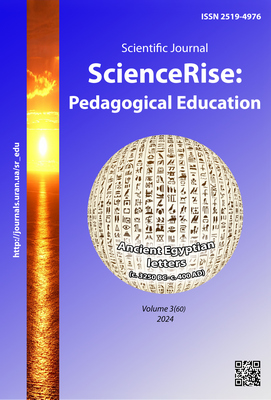Кейс-метод в аспекті формування цінностей майбутніх правників
DOI:
https://doi.org/10.15587/2519-4984.2024.310018Ключові слова:
кейс-метод, формування цінностей, майбутні юристи, правова культура, правові цінності, професійна компетентність, повага до закону, неприпустимість корупціїАнотація
В умовах тривалої російсько-української війні перед українською освітньою галуззю постають нові актуальні завдання, серед яких, зокрема, перегляд підготовки фахівців стратегічних напрямів, до яких належать і юристи. Розвинене національно свідоме громадянське суспільство зі стійкими демократичними переконаннями і неприйняттям корупції, яке ставить інтереси держави на головне місце, є тим ідеалом, який має втілювати сьогоднішнє покоління здобувачів вищої освіти. З урахуванням цього освітні практики мають бути переглянути, передусім в аспекті формування системи цінностей, а також – максимальної актуалізації навчання. Кейс-метод вважаємо одним із дієвих засобів, що відповідає цим важливим завданням. Мета дослідження полягає в осмисленні досвіду використання кейс-методу для формування цінностей майбутніх правників і реалізується в таких завданнях, як дослідження освітніх практик використання кейс-методу, розгляд прикладів використання кейс-методу в навчанні майбутніх юристів, з’ясування впливу кейс-методу на формування цінностей, поваги до закону і неприпустимості корупції у майбутніх правників. Розглянуті в статті приклади використання кейсів присвячені конкретній тематиці – викриттю випадків корупції у системі вищої освіти України. Сформульовано вимоги до змісту кейсів та послідовність роботи з ними, яка передбачає поступове підвищення ступеню самостійності здобувачів освіти. Доведено, що кейс-метод сприяє формуванню у майбутніх правників таких важливих для них цінностей, як повага до закону і неприпустимість корупції. Саме від сформованості цих цінностей залежить розбудова зрілого громадянського суспільства в повоєнній Україні, до якої будуть залучені сьогоднішні здобувачі освіти. Перспективи подальших досліджень вбачаємо у дослідженні використання кейс-методу для аналізу ситуацій, пов’язаних з академічною недоброчесністю
Посилання
- Banakh, V. A., Banakh L. S. (2016). Value orientations transformation of the youth in the conditions of crisis society. Humanitarnyi visnyk ZDIA, 64, 13–21.
- Fedukh, I. S. (2011). Vyznachennia zmistu poniattia «tsinnisna oriientatsiia» u suchasnii psykholoho-pedahohichnii nautsi. Visnyk Natsionalnoi akademii Derzhavnoi prykordonnoi sluzhby Ukrainy, 3. Available at: http://nbuv.gov.ua/UJRN/Vnadps_2011_3_25
- Yan, W. (2023). Research on Case Studies: A Concise Guide on International Law Case Studies. Advances in Applied Sociology, 13 (2), 97–107. https://doi.org/10.4236/aasoci.2023.132006
- Liu, Z. L., Ji, G. M. (2020). Problems and Improvement Strategies of Case Teaching in Law Courses. Vision, 5, 38.
- Ellet, W. (2018). The case study handbook a student’s guide. Harvard Business Review Press Boston, Massachusetts. Available at: http://brandpractitioners.com/wp-content/uploads/2020/06/Harvard-Business-Review-The-Case-Study-Handbook.pdf
- Esponda, P. M., Ezgi, Y., Endres, D., Krisch, N. (2023). The Paths of International Law: Case Studies. The Paths of International Law: Stability and Change in the International Legal Order. https://doi.org/10.2139/ssrn.4430270
- Harrison, H., Birks, M., Franklin, R., Mills, J. (2017). Case study research: foundations and methodological orientations. Forum Qualitative Sozialforschung, 18 (1).
- Mimoso, M. J., Bravo, B. M., Gomes, J. C. (2021). The case study in learning law. International Journal of Innovative Research in Education, 8 (2), 47–53. https://doi.org/10.18844/ijire.v8i2.3247
- Azarov, D. S. (2016). Vchennia pro kryminalno-pravovu kvalifikatsiiu: kilka neochevydnykh funktsii v konteksti vykorystannia metodu «case study». Teoriia kryminalno-pravovoi kvalifikatsii yak fenomen ukrainskoi kryminalno-pravovoi doktryny. Kyiv: Vydavnychyi dim «ArtEk», 11–19. Available at: https://ekmair.ukma.edu.ua/server/api/core/bitstreams/278d7e7a-1ad0-45bc-b773-12805bc31e2c/content
- Kozak, L. V. (2015). Keis-metod u pidhotovtsi maibutnikh vykladachiv do innovatsiinoi profesiinoi diialnosti. Osvitolohichnyi dyskurs, 3 (11), 153–162.
- Pashchenko, T. (2015). Case-method as a modern technology of teaching special disciplines. Molod i rynok, 8, 94–99.
- Pokushalova, L. V. (2011). Metod case-study yak suchasna tekhnolohiia profesiino-oriientovanoho navchannia studentiv. Molodyi vchenyi, 5 (2), 155–157.
- Koicheva, O. S., Yanovska, L. H. (2023). Using the case-study method as an analysis of problem situations in historical education. Innovate Pedagogy, 1 (58), 77–80. https://doi.org/10.32782/2663-6085/2023/58.1.15
- Naumuk, I. (2017). Features of case-study method use in the course of Computer Science teachers' training. Naukovyi visnyk Melitopolskoho derzhavnoho pedahohichnoho universytetu, 2 (19), 132–136.
##submission.downloads##
Опубліковано
Як цитувати
Номер
Розділ
Ліцензія
Авторське право (c) 2024 Svitlana Soshenko, Viktoriia Prylypko

Ця робота ліцензується відповідно до Creative Commons Attribution 4.0 International License.
Наше видання використовує положення про авторські права Creative Commons CC BY для журналів відкритого доступу.
Автори, які публікуються у цьому журналі, погоджуються з наступними умовами:
1. Автори залишають за собою право на авторство своєї роботи та передають журналу право першої публікації цієї роботи на умовах ліцензії Creative Commons CC BY, котра дозволяє іншим особам вільно розповсюджувати опубліковану роботу з обов'язковим посиланням на авторів оригінальної роботи та першу публікацію роботи у цьому журналі.
2. Автори мають право укладати самостійні додаткові угоди щодо неексклюзивного розповсюдження роботи у тому вигляді, в якому вона була опублікована цим журналом (наприклад, розміщувати роботу в електронному сховищі установи або публікувати у складі монографії), за умови збереження посилання на першу публікацію роботи у цьому журналі.









